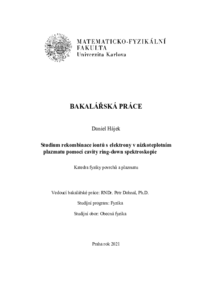Studium rekombinace iontů s elektrony v nízkoteplotním plazmatu pomocí Cavity Ring-Down Spektroskopie
Study of electron - ion recombination in low temperature plasma using Cavity Ring-Down Spectroscopy
bachelor thesis (DEFENDED)

View/
Permanent link
http://hdl.handle.net/20.500.11956/149232Identifiers
Study Information System: 150875
Collections
- Kvalifikační práce [11330]
Author
Advisor
Consultant
Plašil, Radek
Referee
Rednyk, Serhiy
Faculty / Institute
Faculty of Mathematics and Physics
Discipline
General Physics
Department
Department of Surface and Plasma Science
Date of defense
14. 9. 2021
Publisher
Univerzita Karlova, Matematicko-fyzikální fakultaLanguage
Czech
Grade
Excellent
Keywords (Czech)
plazma|spektroskopie Cavity Ring-Down|rekombinaceKeywords (English)
plasma|Cavity Ring Down Spectroscopy|recombinationByl vytvořen kinetický model chování iontů a elektronů uvnitř aparatury určené k měření rekombinačního koeficientu H3O+ . Tento kinetický model ukázal, jaké budou ideální počáteční podmínky v aparatuře, aby bylo možné studovat rekombinaci H3O+ ve stacionárním dohasínajícím plazmatu. Ověřen byl pak také program určený k fitování vývoje koncentrace H3O+ , kterým bylo vyzkoušeno, zda bude schopný fitovat rekombinační koeficient dostatečně přesně. Tento program byl vyzkoušen také na datech, která byla uměle zašuměná. Dále byla provedena kalibrační měření zdroje vody, již pomocí cavity ring-down spektroskopie. Tato měřená ověřovala, jestli jsme schopni dostat do aparatury požadované množství vody. Měření byla provedena při třech různých tlacích, při každém z nich jsme byli schopni ze zdroje do aparatury dostávat dostatek vody, aby měření mohlo podle kinetického modelu dobře proběhnout.
A kinetic model of the behavior of ions and electrons inside the apparatus designed to measure the recombination coefficient of H3O+ was created. This kinetic model showed what the ideal initial conditions in the apparatus would be in order to study recombination of H3O+ in stationary plasma afterglow. The program designed to fit the development of the H3O+ concentration was also verified. The program was tested whether it would be able to fit the recombination coefficient with sufficient accuracy. This program was also tested on data that was artificially edited adding normally distributed noise. Furthermore, calibration measurements of the water source were performed, using cavity ring-down spectroscopy. This measurement verified whether we were able to get the required amount of water into the apparatus. The measurements were performed at three different pressures, at each of which we were able to receive enough water from the source to the apparatus so that the measurement could proceed well according to the kinetic model.
